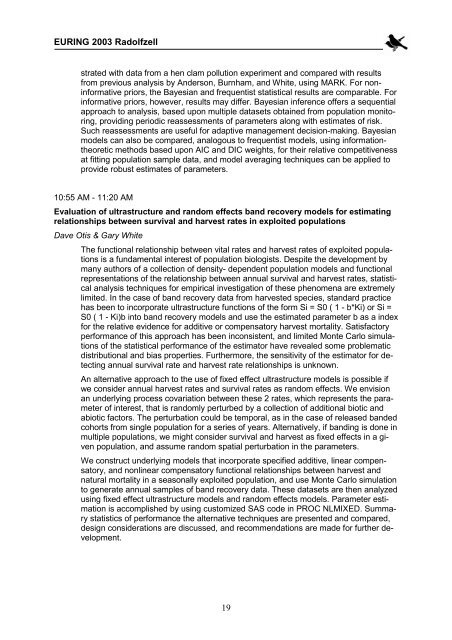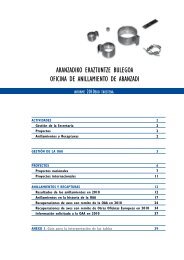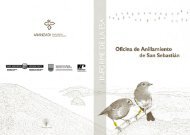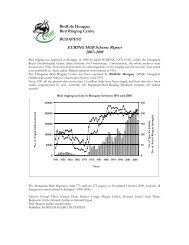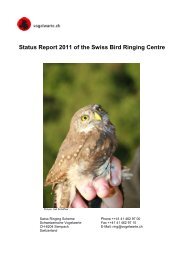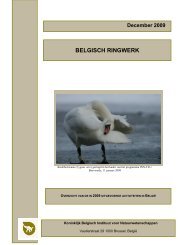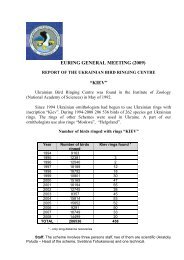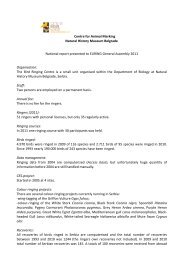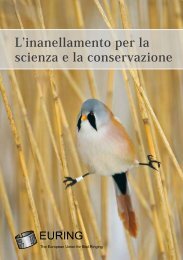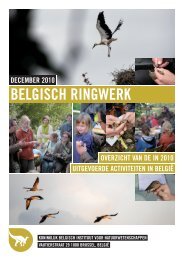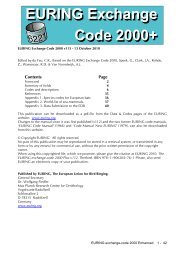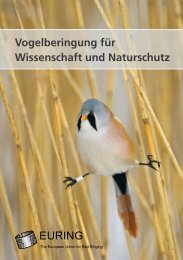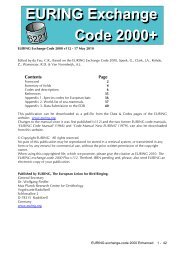The quantitative study of marked individuals in ecology, evolution ...
The quantitative study of marked individuals in ecology, evolution ...
The quantitative study of marked individuals in ecology, evolution ...
Create successful ePaper yourself
Turn your PDF publications into a flip-book with our unique Google optimized e-Paper software.
EURING 2003 Radolfzell<br />
strated with data from a hen clam pollution experiment and compared with results<br />
from previous analysis by Anderson, Burnham, and White, us<strong>in</strong>g MARK. For non<strong>in</strong>formative<br />
priors, the Bayesian and frequentist statistical results are comparable. For<br />
<strong>in</strong>formative priors, however, results may differ. Bayesian <strong>in</strong>ference <strong>of</strong>fers a sequential<br />
approach to analysis, based upon multiple datasets obta<strong>in</strong>ed from population monitor<strong>in</strong>g,<br />
provid<strong>in</strong>g periodic reassessments <strong>of</strong> parameters along with estimates <strong>of</strong> risk.<br />
Such reassessments are useful for adaptive management decision-mak<strong>in</strong>g. Bayesian<br />
models can also be compared, analogous to frequentist models, us<strong>in</strong>g <strong>in</strong>formationtheoretic<br />
methods based upon AIC and DIC weights, for their relative competitiveness<br />
at fitt<strong>in</strong>g population sample data, and model averag<strong>in</strong>g techniques can be applied to<br />
provide robust estimates <strong>of</strong> parameters.<br />
10:55 AM - 11:20 AM<br />
Evaluation <strong>of</strong> ultrastructure and random effects band recovery models for estimat<strong>in</strong>g<br />
relationships between survival and harvest rates <strong>in</strong> exploited populations<br />
Dave Otis & Gary White<br />
<strong>The</strong> functional relationship between vital rates and harvest rates <strong>of</strong> exploited populations<br />
is a fundamental <strong>in</strong>terest <strong>of</strong> population biologists. Despite the development by<br />
many authors <strong>of</strong> a collection <strong>of</strong> density- dependent population models and functional<br />
representations <strong>of</strong> the relationship between annual survival and harvest rates, statistical<br />
analysis techniques for empirical <strong>in</strong>vestigation <strong>of</strong> these phenomena are extremely<br />
limited. In the case <strong>of</strong> band recovery data from harvested species, standard practice<br />
has been to <strong>in</strong>corporate ultrastructure functions <strong>of</strong> the form Si = S0 ( 1 - b*Ki) or Si =<br />
S0 ( 1 - Ki)b <strong>in</strong>to band recovery models and use the estimated parameter b as a <strong>in</strong>dex<br />
for the relative evidence for additive or compensatory harvest mortality. Satisfactory<br />
performance <strong>of</strong> this approach has been <strong>in</strong>consistent, and limited Monte Carlo simulations<br />
<strong>of</strong> the statistical performance <strong>of</strong> the estimator have revealed some problematic<br />
distributional and bias properties. Furthermore, the sensitivity <strong>of</strong> the estimator for detect<strong>in</strong>g<br />
annual survival rate and harvest rate relationships is unknown.<br />
An alternative approach to the use <strong>of</strong> fixed effect ultrastructure models is possible if<br />
we consider annual harvest rates and survival rates as random effects. We envision<br />
an underly<strong>in</strong>g process covariation between these 2 rates, which represents the parameter<br />
<strong>of</strong> <strong>in</strong>terest, that is randomly perturbed by a collection <strong>of</strong> additional biotic and<br />
abiotic factors. <strong>The</strong> perturbation could be temporal, as <strong>in</strong> the case <strong>of</strong> released banded<br />
cohorts from s<strong>in</strong>gle population for a series <strong>of</strong> years. Alternatively, if band<strong>in</strong>g is done <strong>in</strong><br />
multiple populations, we might consider survival and harvest as fixed effects <strong>in</strong> a given<br />
population, and assume random spatial perturbation <strong>in</strong> the parameters.<br />
We construct underly<strong>in</strong>g models that <strong>in</strong>corporate specified additive, l<strong>in</strong>ear compensatory,<br />
and nonl<strong>in</strong>ear compensatory functional relationships between harvest and<br />
natural mortality <strong>in</strong> a seasonally exploited population, and use Monte Carlo simulation<br />
to generate annual samples <strong>of</strong> band recovery data. <strong>The</strong>se datasets are then analyzed<br />
us<strong>in</strong>g fixed effect ultrastructure models and random effects models. Parameter estimation<br />
is accomplished by us<strong>in</strong>g customized SAS code <strong>in</strong> PROC NLMIXED. Summary<br />
statistics <strong>of</strong> performance the alternative techniques are presented and compared,<br />
design considerations are discussed, and recommendations are made for further development.<br />
19


